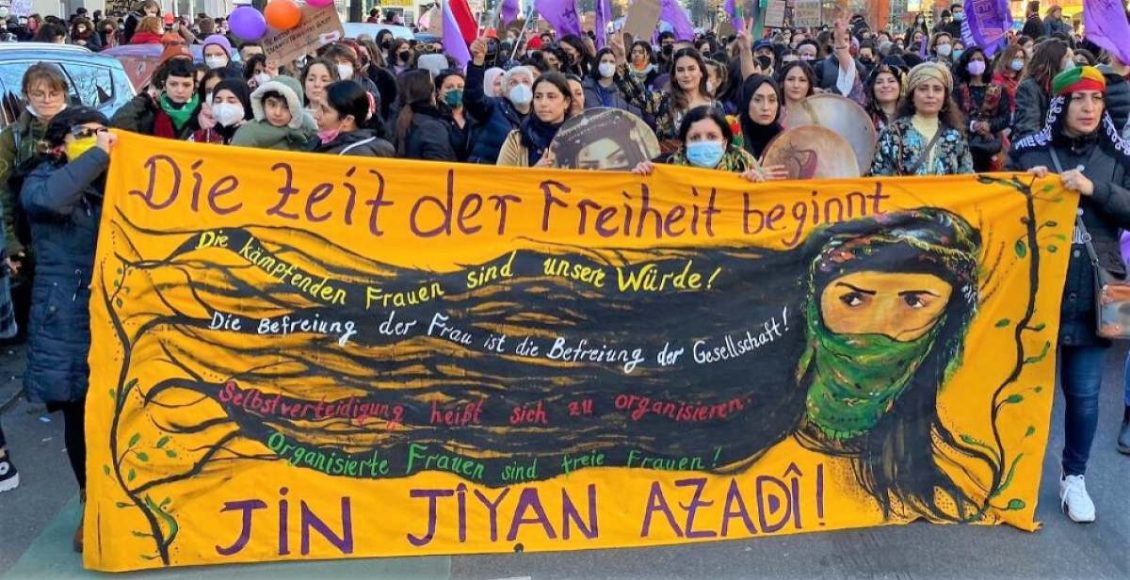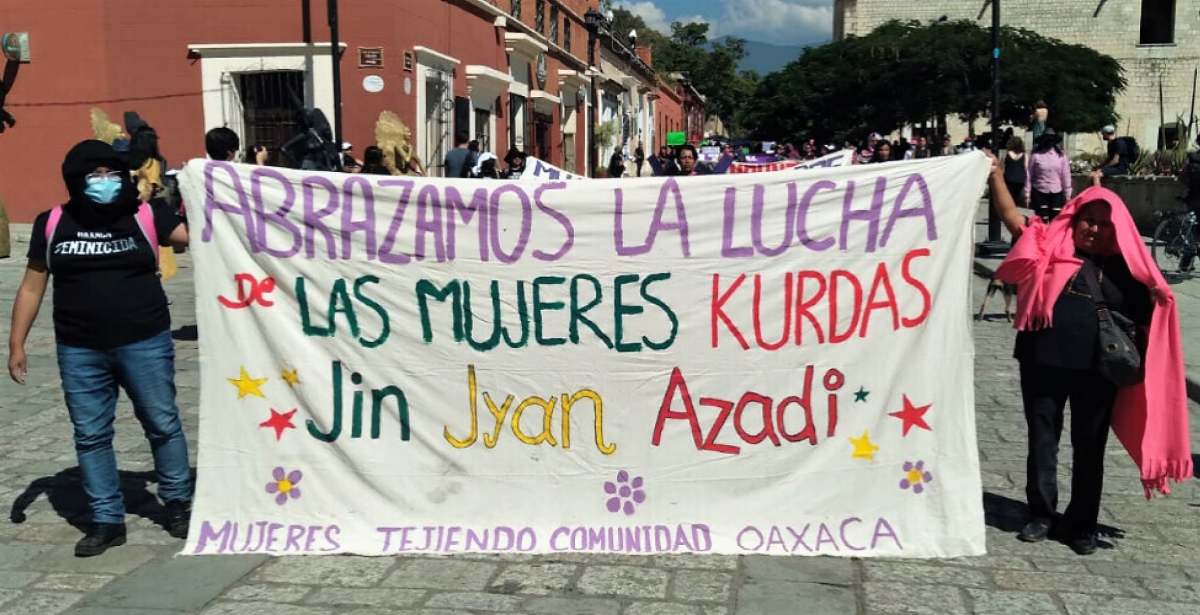The Global Impact of Jin, Jiyan, Azadî
By Rojin Mukriyan

As we approach the first anniversary of the “Jin, Jiyan, Azadî” (Woman, Life, Freedom) revolutionary movement in Eastern Kurdistan (Rojhilat) and Iran, it is beneficial to investigate its global impact. I have examined the implication of this movement in global terms at two levels: its impact on state-centric politics and its impact on grassroots feminist political organization. In doing so, this paper argues that the political theory behind Jin, Jiyan, Azadî has the potential to lead the women’s revolution in the 21st century.
Of note, the main ideas of the Jin, Jiyan, Azadî movement were born in the Qandil mountains through a long history of Kurdish women’s resistance and struggle against both internal and external patriarchal colonization. The slogan was formulated in Imrali prison by the imprisoned leader and Kurdish political theorist, Abdullah Öcalan. From the Qandil mountains, Kurdish women built their grassroots solidarity with other women in different parts of Kurdistan and beyond. In such a way, Jin, Jiyan, Azadî mobilized the Kurdish women in Northern Kurdistan (Bakur) and Turkey. It then characterized the women’s revolution in Rojava and Syria under the YPJ (Women’s Protection Units). And now it has become a unified motivation for the revolutionary movement in Rojhilat and Iran. As a result, it also became a prominent mobiliser for the feminist movement around the world, held up by the precepts set out within Jineology.
Global Impact on State-Centric Politics
Jin, Jiyan, Azadî was chanted by a young Kurdish woman throwing off her compulsory hijab during the burial of Jîna Aminî in Ayçî cemetery in Saqqiz, the hometown of Jîna on September 16th 2022. Jîna Aminî was a 22-year-old Kurdish woman who was murdered by the so-called “morality police” for wearing an “improper” hijab. Since then, the Kurdish phrase Jin, Jiyan, Azadî emerged as a prominent slogan for a revolutionary movement in Rojhilat and Iran in defiance of Jîna’s treatment and the broader treatment of women.
The revolutionary movement of Jin, Jiyan, Azadî in Rojhilat and Iran sparked diverse reactions globally. As the people in Rojhilat and Iran were occupying the streets, Western powers started to support the movement. For example, Melania Joly, Canadian foreign Minister, tweeted, “the women of Iran are speaking clearly. No longer will they tolerate the regime’s vision of women in society.” While French President Emmanuel Macron called it a revolution. Following the brutal crackdown on protestors by the Iranian regime, the UN Human Rights Council decided to establish an independent International Fact-Finding Mission to investigate the human rights violations in Iran during the protests that began on in September 2022. Iran was also removed from the UN Commission on the Status of Women. For their part, the European Parliament voted in favor of the designation of the Iranian Revolutionary Guard Corpse (IRGC) as a terrorist organization in January 2023.
However, many of the politicians who opportunistically chanted ‘Women, Life, Freedom’, have also criminalized the KCK-led (Kurdistan Communities Union) freedom movement from which Jin, Jiyan, Azadî originated by providing weapons to NATO-member Turkey, which had the effect of aiming to eliminate the very women who are the real founders of the slogan. This revolutionary movement has also provoked superficial sentimentalism. Consider celebrities and politicians cutting their hair on social media and during public protests. These acts might have had a detrimental impact on the movement as they reduced the broader revolutionary movement to the issue of “veiling” or “unveiling.” But the issues at stake were far broader than just mandatory hijabs. Thus, to transform the movement into a liberal feminist movement concerned primarily with clothing was not terribly helpful. Many politicians and even right-wing parties denounced the Islamic regime and supported the revolutionary movement. On the other hand, one could tell their denunciations were them simply aligning themselves with their specific state’s geopolitical interests against Iran.
The intentions behind Western powers’ support of the movement were mostly twofold. First, there was an attempt to steer and even control the revolutionary movement by reducing it to “regime change” protests. They pursued this by imposing a monolithic leader on the movement, a “leader” who was actually not one at all. They used their state power and resources to create more individualistic leaders, figures, and celebrities for the people in Iran. They tried to promote the social status of Reza Pahlavi, the son of Mohamad Reza Shah, the previous Shah of Iran. For this purpose, the Iranian right-wing opposition was invited to the Munich Security Conference on 18 February 2023. This was an act that had a detrimental impact on the grassroots movement inside Rojhilat and Iran.
Secondly, many Western powers utilized the movement as a pawn in its negotiations with Iran concerning the possible revival of the scrapped nuclear Iran deal. The deplorable behavior by the Iranian regime in response to the protests was used as a negotiating tactic to gain negotiating leverage by the West. The beginning of the movement coincided with an emerging crisis at the global level, such as a stalling of nuclear talks between Iran and West, the intensification of the Ukraine-Russia war, the post-covid crisis, inflation, and so on, all of which had been labeled by some as the “polycrisis.”
In other words, global powers perceived the movement as an opportunity that needed to be seized. They utilized the movement to put pressure on the Iranian regime for their own political and economic interests. For instance, China successfully brought Saudi Arabia and Iran together to restore relations in the context of the instability wrought by the protests. They did so by expanding the Shanghai Cooperation Organization and BRICS and making on offer of Iranian inclusion which was too good to pass up. To counter Chinese influence, the US mostly successfully froze its tensions with Iran as it sought to secure freedom for US nationals who were held hostage by the Iranian regime, and put a cap on the uranium enrichment activities of Iran.
In March 2023, diplomats from France, Germany, and the UK who were supporting the movement, visited their Iranian counterpart in Oslo to normalize relations. A US state department spokesperson in response to their negotiations with the Iranian regime said, “We have the means to communicate with Iran and deliver messages to them, when it is in America’s interest to do so.” The interactions amongst global powers in response to the revolutionary movement of Jin, Jiyan, Azadî demonstrated that nation-states are self-interested and patriarchal institutions. They are principally male-dominated power-oriented institutions that enhance and enforce patriarchy through shallow and cynical manipulation of genuine movements for gender equality. The aim of such institutions is only to increase their own power by holding societal movements hostage. Such a model is certainly not in the business of liberating oppressed groups who challenge members states of the recognized cabal. Moreover, one could claim that most of the state support for this revolutionary movement was based on implicit patriarchal solidarity, an inverse solidarity that links domination and oppression from households to world politics, through the shared interest of keeping the vast majority of women in a subaltern position.

Global Impact on Feminist Grassroots Solidarity
Women have always actively participated in struggles for equality and liberty within their societies. They joined the resistance and liberation movements to fight against fascism, colonialism, and apartheid, as well as for sovereignty and national liberation in different parts of the world. One recent example of this is the vital contribution of women to the Arab Spring uprisings. Despite their contribution, many women remained dominated within Arab societies. For example, the number of female legislators in the Arab spring countries actually declined. In Egypt, for instance, the number of women in the People’s Assembly dropped from 64 (out of 518, 12.4%) under Hosni Mubarak to 10 (out of 508, 2.0%) under Mohamed Morsi.
Several different waves of feminism have emerged since the 19th century, each achieving some degree of gender liberty and equality. However, the patriarchal nature of society still is in force as political power continues to be aligned with male-dominated social structures. One reason for this is that these feminist movements are either only offered a state-centric approach that mirrors the entire patriarchal civilizational process, or fail to propose an implementable alternative to the existing system. And it is the system itself that reinforces the norms and values which perpetuate its continuation.
One can say that we still live in a world with a patriarchal and misogynist mindset. For example, data indicates that for every three women, one is subjected to domestic violence. Domestic violence itself is related to state violence against women. Women are also still underrepresented in politics and there is still a huge gap in the attainment of political equality for women. As for the metrics, there are only 31 countries where women serve as head of state or government, while globally, women only constitute 26.5% of parliamentarians in single or lower houses. Shockingly, only six countries have reached at least a level of gender parity with 50% or more women in their parliament, while globally, women constitute only 22.8% of cabinet ministers. It is not an exaggeration to argue that women around the world are still dominated and underrepresented.
Moreover, gender equality within the existing state-centric system, which is a system based on hierarchy and domination, is incomplete and exclusive. It can only incorporate a very limited number of undominated women. Therefore, to achieve genuine liberty that is a combination of collective self-determination and freedom as non-domination, we need to break with the existing system.
The shared experience of patriarchal oppression under authoritarian states and patriarchal societies connects the Kurdish women’s movement and their slogan of ‘Jin, Jiyan, Azadî’ to the struggle of other women in the region and around the globe. As Azra Rashid argues, Jîna’s death has breathed soul back into feminist movements across the globe. It became an inspiration for women all around the world. It is a hope for all women who suffer similarly. The slogan was chanted in many cities of Latin America, Europe, and the United States. It brought 700 women from 41 countries together in a two-day conference in Berlin in November 2022, where concepts such as world women’s confederalism were discussed under the umbrella of Jin, Jiyan, Azadî.
But it is important to ask ourselves why Jin, Jiyan, Azadî became a global slogan in the past year? One reason for this is that the political theory behind the slogan not only provides a comprehensive analysis and critique of the origins of the current crisis, but it also offers an implementable alternative to the existing system, an alternative that only a women’s revolution can secure. To understand this, we need to understand the ideas behind the slogan. The original thinking behind the phrase Jin, Jiyan, Azadî was generated from the political theory of the Kurdish leader Abdullah Öcalan, the imprisoned political theorist and leader of the Kurdistan Workers’ Party (PKK) and its various offshoots. For sure, Öcalan was inspired by the struggles and resistance of Kurdish women in the Kurdish liberation movements before him. He says that the 5,000-year-old history of civilization is first and foremost the history of the enslavement of women.
It can be said that civilization is, for Öcalan, a series of overlapping forms of domination and enslavement, with women serving as the ‘first colony’ of civilization. He regards women as the first and thus most dominated and enslaved group of civilization. In other words, the domination of women is the foundation of all other forms of domination. Therefore, he believes a gender revolution is necessary. No other kind of liberation from enslavement and domination will fully improve the human condition until women are fully liberated. Thus, Öcalan argues that society will not be free without the liberation of women as women represent the power of the organic, natural, and egalitarian societies that characterized the hunter-gather lives of humans prior to the advent of civilization. The phrase Jin, Jiyan, Azadî expresses this liberatory intent of Öcalan’s understanding of the origin of patriarchy.
“The extent to which society can be thoroughly transformed is determined by the extent of the transformation attained by women. Similarly, the level of woman’s freedom and equality determines the freedom and equality of all sections of society.”
— Abdullah Öcalan, Liberating Life: Woman’s Revolution (2013)
For Ocalan, patriarchy is an at least 5,000-year-old constructed system (social, cultural, economic, and political system) that can and must be abolished not through reform, but a process of ‘women’s revolution’. Of course, patriarchy varies in different contexts. However, it produces and reproduces itself globally through ideology, science, education, race, class, religion and media in a statist and capitalist world system. This is to say that patriarchy has been normalized and institutionalized in every sphere of life. It manifests itself in society. Therefore, for women to achieve their liberty, they need to become a collective force aiming to overcoming the overarching effects of patriarchy. Nevertheless, it is important to emphasize that women are essential for the liberty of society not only for material reasons, in which they constitute ‘half of society’, but because of their status as the ‘first colony,’ because all other forms of violence and domination are built upon women’s domination and gender-based political violence. Women around the world instinctively saw that this is what the slogan of Jin, Jiyan, Azadî ultimately entailed.
What is a Women’s Revolution?
By ‘women’s revolution,’ what is meant is not an abstract utopia. It also does not refer to only a women’s movement in the sense that only women are allowed to participate. It is a revolution that women are leading to bring fundamental change within the mindset of the society, culture, economics, politics, and more importantly power relations of all nations on earth. It is a revolution that does not seek to freeze the crisis, but attempts to eliminate the causal root. It is a revolution that does not seek shelter in the shadow of the existing system. Rather, it strives to bring fundamental change within all spheres of life. It is a revolution that believes in harmony and peaceful co-existence. It does not seek to exchange a patriarchal form of hierarchy and domination for a matriarchal one. Rather, it believes that only through a libertarian and egalitarian system where power is distributed horizontally, can we achieve harmony and liberty. It is a revolution that centers women’s liberation in its forefront because it considers the domination and colonization of women as the first form of colonization and domination that other forms of colonization and domination are built upon.
To conclude, one can say that the Kurdish freedom movement and struggle is a fight against the many layers of colonization that accumulated over history. Its aim is not merely to liberate Kurdistan from the colonization implemented by the dominant states occupying Kurdistan (Iran, Iraq, Turkey, and Syria). It is an overall attempt to also decolonize life from power. Kurdish women are a colony within a colony and their revolution is a revolution within a revolution. Jin, Jiyan, Azadî did not only challenge the existence of the Iranian regime. It also offers an alternative to existing global politics, existing social, political, cultural, and economic structures.
Slogans, ideas, and symbols can change as they cross borders. While internationally, mainstream media, politicians, brands, and celebrities tried to remove the revolutionary sentiment behind the slogan, ‘Jin, Jiyan, Azadî’, it has only become stronger each time it traversed a new line on the map. It created a grassroots solidarity network between all feminists who seeks inclusion based on plurality and diversity. It also became a prominent motivation for feminist movements around the world as it offers an implementable solution to the deep crisis of civilization, with that solution being a truly egalitarian system of direct democratic participation. It has preserved and enhanced its revolutionary sentiments. For instance, a woman in Tehran reminded the Western media that Jin, Jiyan, Azadî is “a critique of unequal power relations in all forms—of anyone who is stepping on your rights and limiting your freedom.” Patriarchy as a global phenomenon is not an eternal or natural principle of history, but it is a result of historical practices. Therefore, it can be deconstructed and dismantled. On the one year anniversary of Jîna’s death, let us remember that and continue to fight for her through the ongoing Jin, Jiyan, Azadî movement. Its impact shall therefore remain global.



Comments are closed.